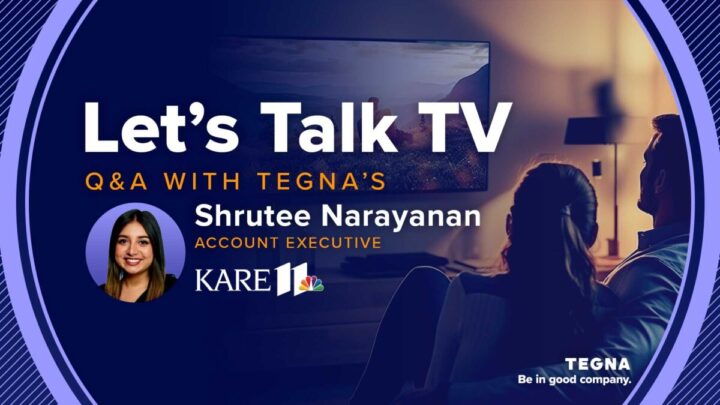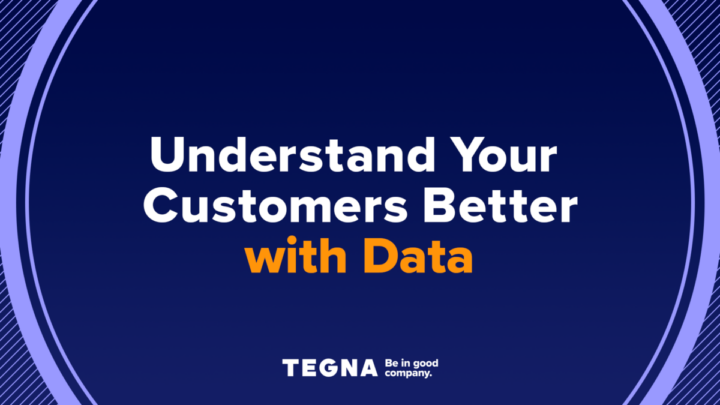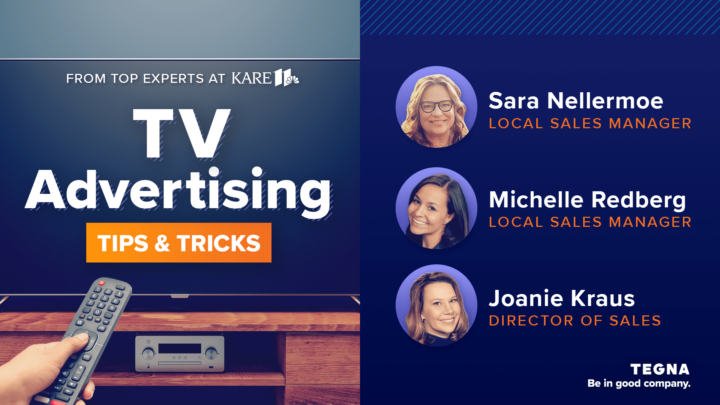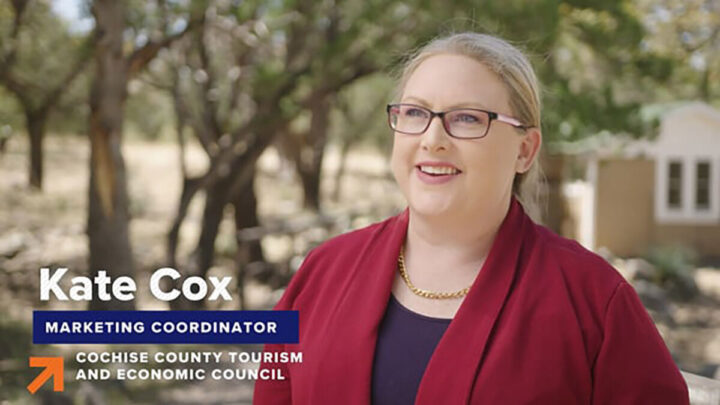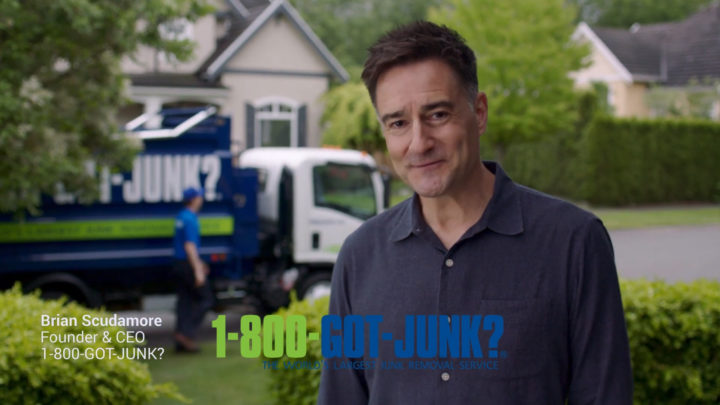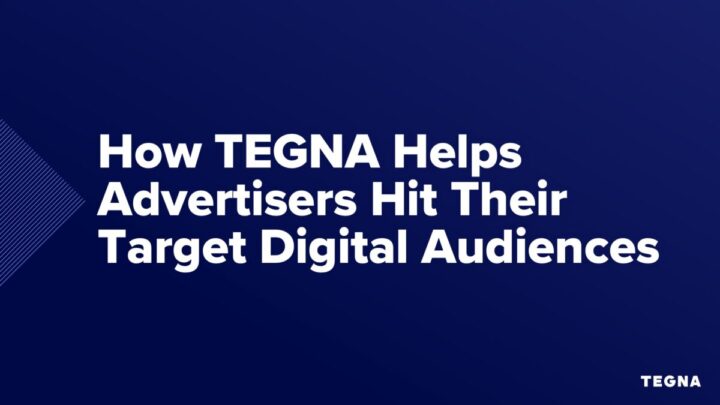7 Reasons for Local Businesses to Invest in Video Marketing
Consumer demand for video content is strong, influencing purchase decisions for 89% of consumers. The versatility of video marketing has many benefits, and we’ve enlisted the help of TEGNA’s Jeff Beacham and Deirdre Abels at WGRZ in Buffalo to help us understand the significance of video marketing.
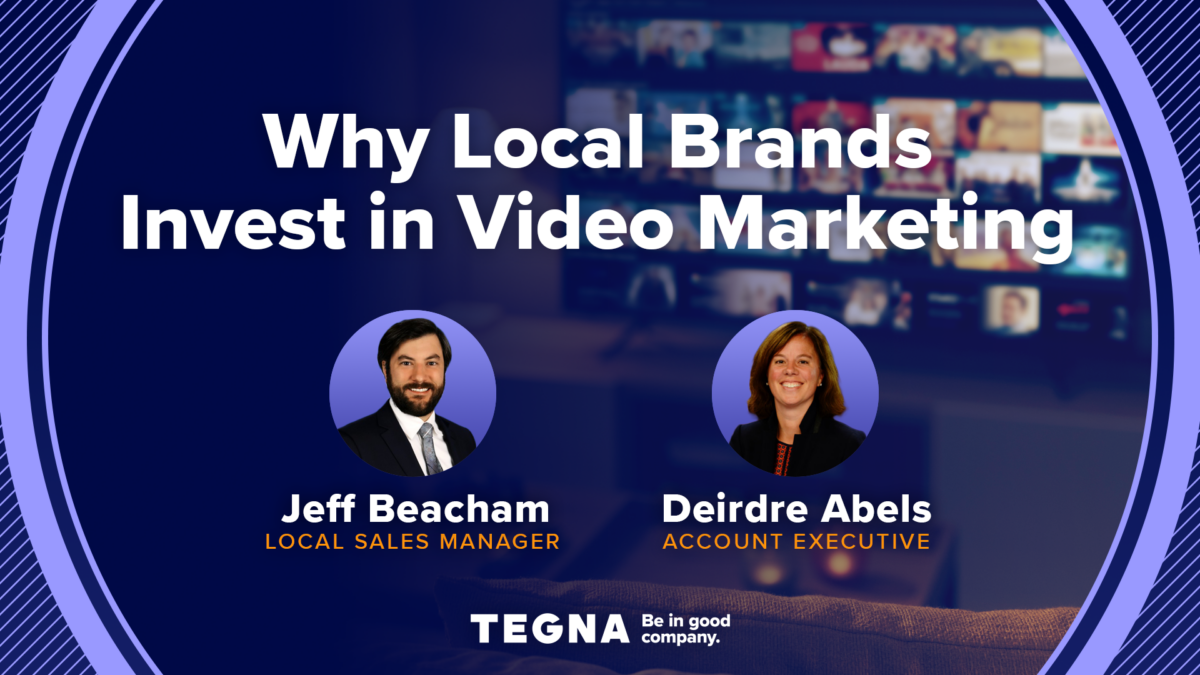
Adopting innovative marketing strategies is imperative for local businesses (looking?) to stay ahead. Video marketing is a critical tool in these efforts and a game-changer in connecting with target audiences and fostering business growth.
To help us understand the significance of video marketing and explore various aspects that local businesses should consider, we’ve enlisted two of TEGNA’s local media experts, Jeff Beacham, Local Sales Manager, and Deirdre Abels, Account Executive, at TEGNA’s WGRZ in Buffalo.
From meeting the evolving demands of consumers to establishing cost-effective brand visibility, showcasing unique identities, building community connections, and leveraging the trust-building power of video, here are their tips and best practices to help inform your next video marketing campaign.
An Overview of Video Marketing for Local Businesses
TV advertising has been an effective way to market a brand, build awareness, and grow local businesses for a long time. However, how we define “TV advertising” has changed over the last decade, expanding to include streaming and digital channels. These channels all leverage the power of video to engage viewers.
It should come as no surprise that HubSpot’s 2024 State of Marketing & Trends Report found that short-form video is now the most popular marketing format and offers the highest ROI. That’s because there is consumer demand for video content – even from brands. Findings from a recent Wyzowl study also back this up:
- 91% of people say they want to see more online videos from brands (up from 85% in 2018)
- 79% indicated that they “Very much” or “Somewhat” enjoy watching video content from brands online
- Less than 3% don’t like watching brand video content at all
What could be behind this consumer preference? Video helps guide and influence purchase decisions.
- 89% say watching a video has convinced them to buy a product or service (up from 73% in 2015)
- Channel 66% of consumers have watched video content (product demos, reviews, FAQs, unboxings) to learn about a brand or product
Businesses that Can Benefit from Video Marketing
Video marketing is a versatile and engaging medium that effectively communicates messages to diverse audiences and benefits businesses of all shapes and sizes. They include hospitals and health care facilities ranging from optometrists and dentistry to urgent care, auto dealerships, law firms, home services providers like plumbers, travel and tourism destinations, and more.
Where to Promote Videos
A strong video marketing strategy has a broad reach that is not limited to one channel or format. It can be used for traditional TV, streaming, and digital channels. Here are a few places to run video for the best business outcomes.
Television Advertising
Broadcast and linear TV have long been effective platforms for advertisers looking to reach a large audience and create brand awareness. The platform offers reach to large and engaged audiences, alignment with trustworthy and tentpole content, and, most importantly, high recall. MediaScience found that ads on a TV screen saw a 2.2 times higher unaided recall and 1.3 times higher purchase intent than smaller, digital screens.
“I think TV’s the most efficient way to use your dollars,” says Abels. “It’s the absolute best way to reach the most people quickly with your messaging.”
“With the right creative message, TV campaigns will pay for themselves and then some,” says Beacham.
“When a brand is in the spotlight and showcased in an ad on TV, consumers automatically trust that personality because they can see them. They become familiar,” says Abels. “Video helps brands elevate their business over the competition who do not have a presence on TV. They’re reaching the audience where they are.”
Streaming/ OTT
As streaming viewership continues to rise, StreamTV reports that audiences are embracing ads on streaming platforms, especially if it means saving money on their subscriptions. But that’s not the only benefit of streaming TV advertising.
“In many ways, streaming video has the same principles as traditional TV,” says Abels. “It helps create trust and make an emotional connection, but it also lets you add new layers into the mix regarding targeting and measurement.”
For example, streaming television lets advertisers extend their reach by capturing the attention of the cord-cutters and cord-nevers. It also enables brands to narrow target audiences based on market or geography, from regions and states to ZIP codes and consumer trends such as interests, intenders, and in-market shoppers.
A measurement tool like TEGNA Attribution also enables brands to gauge its impact by linking viewership patterns to KPIs, so advertisers can now identify who viewed an advertisement and then visited their website or storefront. This data demonstrates the efficacy of TV/OTT schedules in generating business outcomes, quantifying the expanded reach of OTT campaigns. Now, advertisers can make informed optimizations and enhance the overall efficiency of their campaigns.
Digital Channels
Digital channels can further extend a campaign’s reach and improve recall. Digital also provides advantages in that it has measurement tools and analytics that provide data to inform and optimize campaigns.
“With digital, we can tell you which creative is performing better. “If we’re running three pieces of creative, we can pull whichever ad isn’t resonating with the audience off of digital and linear channels,” notes Abels. “Then, we can rerun the best creative using retargeting.”
Additionally, video can increase engagement and the shareability of your content on digital channels. If you’re running digital video in partnership with your local broadcast news station, consider adding it to your YouTube, Facebook, or other social sites.
The Power of Video: Why Local Businesses Should Invest
Several studies have shown that brands that decrease their advertising spending also see declining business results. On top of FOMO (the “fear of missing out”), here are a few reasons why local businesses need to invest in video marketing to increase brand awareness:
1. Meet Growing Consumer Demand
Wyzowl found that 89% of consumers strongly want to see a brand’s video content and a captivating medium for audiences to help your brand maintain a competitive advantage.
2. Cost-Effective
There’s a preconceived notion that TV and video advertising is too expensive, but it’s a myth Abels dispels.
“Every brand has different budgets, but we’re able to work with businesses of all shapes and sizes. Video, specifically TV, is the best way to reach the most people quickly. It works, and it’s an extremely efficient media buy. It doesn’t necessarily cost $100,000 a month to run a television campaign to have it work.”
What about video production? Partnering with your local news station to craft your creative is also an effective way to stay within your budget.
“Our production team at WGRZ creates great video assets, and our partners can walk away with amazing creative to represent the brand that works well on linear and streaming platforms, as well as their website or social media,” says Beacham.
3. Showcase Your Brand
Video allows brands to tell their stories uniquely, showcasing their products and personalities.
“With TV, viewers get to feel the brand when introduced into the market,” notes Beacham. “Seeing a business owner and their character before ever stepping foot in their store, there’s already that sense of familiarity that makes the sales cycle that much easier.”
“You can see the work being done. You hear the story. You see why you should shop there,” adds Abels. “Compare that to a static image with a logo slapped on it … it won’t have the same effect on a consumer. A consumer prefers to hear the jingle and see the person in action rather than see a static picture.”
“There’s nothing more powerful than a true testimonial, seeing and hearing somebody tell their story and their experience,” says Beacham. “With sight and sound, video allows you to capture these emotions in visual ways radio, billboards, and print can’t.”
4. Make Strong Community Connections
Audiences, especially millennials, are more involved in their local communities than ever before and are increasingly looking to do business with brands that are a part of the local fabric, share their values, and give back to the community.
- The Integer Group says that 57% will support brands that give back to local communities rather than supporting global or national causes.
- The Blackhawk Network found that 60% of consumers want to buy from companies that give back to charitable causes.
Most notably, 40% of consumers hear about a brand’s charitable efforts through advertising, while 28% hear about it through news media. This shows that teaming up with community members – like your local news station – can put your video in front of local audiences looking for local brands to support.
“Our station is always so involved with local community events,” notes Beacham. “That means our clients can be a part of the causes we’re a part of, whether it’s a specific parade, a food drive, military appreciation, or a school backpack drive.”
“It’s a great opportunity to do your part in helping folks in your community that you don’t get elsewhere. WGRZ viewers are involved in the community and want to do business with people who care about local causes.”
5. Build Trust & Credibility with the Halo & Hollywood Effects
Trust and credibility are decisive factors in consumers’ purchase decisions, and video helps to apply the halo effect, especially when video leverages local community partners, such as your local news station.
TVB found that local broadcast news is the most trusted platform among viewers, and studies show that consumers are more likely to trust – and buy from – brands that advertise alongside sources of information they trust, such as local news.
“Our viewers trust our station, anchors, and journalism,” says Abels. “So when our viewers see a brand advertising on our station, they automatically trust that brand because they trust us. They know we don’t work with problematic or sketchy companies.”
- It’s not just news that viewers trust. Research shows testimonial videos are compelling because the messaging comes from peers rather than the brand itself. As a result, 2 in 3 consumers are more likely to purchase after watching a testimonial video detailing how the brand has helped them in real life.
Video marketing also has the power to turn local business owners into celebrities.
“I have clients who have advertised on TV for years, and they can’t walk into the supermarket or a restaurant without people recognizing them and asking to take their picture with them,” says Abels.
“So the trust factor is there from them doing years of TV campaigns with WRGZ. Being in the spotlight brings automatic trust and credibility, which helps to elevate their business over another brand not doing video advertising,” says Abels.
6. Cross-Channel Marketing
The beauty of video marketing is that it easily lends itself to a cross-channel marketing approach.
“Individuals are consuming media on so many different platforms. It’s necessary to be on their television, streaming device, and mobile phone so you can stay front and center,” Beacham says.
“You can get many uses out of one video,” notes Abels. “You can have one minute, a 30-or-15-second spot, and repurpose that video for linear, streaming, and digital channels. That’s a key component to an effective cross-platform strategy.”
“Video is one of the best marketing values you can get. We want our clients to be empowered with that marketing ammo,” adds Beacham. “The evolution of marketing now also includes retargeting. Let’s say a viewer watches Sunday Night Football, where they see your ad. The next day, they stream different content and see the same ad. If your ad isn’t in the forefront regularly, it may not have the desired impact. We need more frequency and strategy than ever in our content-heavy environment.”
7. Increase Measurable Key KPIs
Investing in video marketing can significantly benefit local businesses. 90% of marketers surveyed by Wyzowl say video has helped them increase ROI and several KPIs, including brand awareness (90%), web traffic (86%), time on site (82%), generated leads (87%), and directly increase sales (87%). Additionally, local businesses can create impactful content for a cross-channel strategy without breaking the bank.
How do we know video is working to move the needle?
Video marketing platforms often provide analytics that allows businesses to track campaign performance. Use a tool like TEGNA Attribution to see who viewed an ad and then took action, along with other tools to measure website traffic, conversions, email open rates, phone calls generated, and other metrics outlined in your media plan. This data can be valuable for refining strategies and understanding what resonates with the local audience.
Examples of Successful Video Ads
Giving credence to the fact that all industries can benefit from TV advertising, the creative below from Penn Dixie Fossil Park and Nature Reserve, produced by TEGNA’s WGRZ, shows nothing wrong with using humor to increase brand awareness and recall. Not only did the spot bring smiles to the faces of its viewers, but the brand was also able to benefit from that trust factor and halo effect that local news provides.
An example of another partner of WGRZ, Napoli’s commercials effectively combine the allure of luxury menswear with compelling storytelling, exceptional production quality, a connection to the local community, and strategic advertising placement. These elements collectively contribute to the effectiveness of Napoli’s marketing strategy, fostering brand loyalty and attracting customers seeking a premium menswear experience in Buffalo, New York.
Rustic Buffalo Artisan Market can leverage the halo effect using long-form video to inform and educate viewers on its location, events, and local artists it teams within the community.
Start Benefiting from Video Advertising with TEGNA
Don’t let your video advertising remain a mystery—let’s unravel its impact together.
Our experts at TEGNA specialize in maximizing advertising ROI across broadcast and streaming television and digital platforms. With a history of delivering results for businesses of all sizes, we’re committed to unlocking the full potential of your video advertising efforts. Contact us now to see how TEGNA can supercharge your ROI and elevate your brand to unprecedented success.
Frequently Asked Questions
How do I make a video for marketing my business?
Creating a marketing video can be a complete and cost-efficient way to connect with your audience. First, you’ll need to define the goals of your video and gain an understanding of your target audience’s wants, needs, and pain points and how you can help solve them. Next, create a compelling story that is relatable, funny, or creates an emotional connection. You’ll want to focus on the most critical information to keep viewers engaged and the video concise. You’ll also need to invest in good lighting, a decent camera, and clear audio because visual appeal is crucial for attracting viewers. You can also consider enlisting the help of your local community partners, like the marketing experts at TEGNA, who can help you craft the perfect creative using data and insights.
How do I market my business in my local area?
Video marketing is an excellent option for brands looking to build awareness. The engaging nature of video allows consumers to become familiar with your products and the faces behind the brand. Consider partnering with local community organizations – such as your local news station – to create a video for broadcast and streaming TV and digital channels.
What are some tips for getting started with video marketing?
Creating compelling video ads requires a thoughtful approach and set goals to reach. First, you’ll want to understand your target audience well and which platforms they choose to watch videos. Next, you can craft your story based on your unique brand’s selling points and the problems your brand solves for the viewers. With your video created, you can create a media plan that details the timeline, platforms, budget, and how to measure the KPIs of the campaign.

